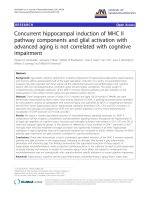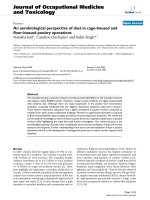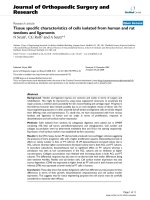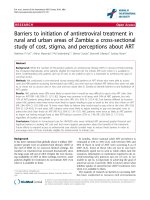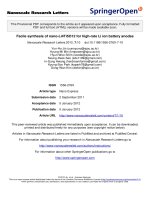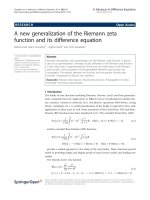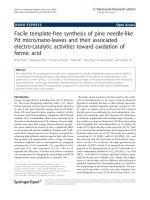Báo cáo hóa học: " Facile template-free synthesis of pine needle-like Pd micro/nano-leaves and their associated electro-catalytic activities toward oxidation of formic acid" pot
Bạn đang xem bản rút gọn của tài liệu. Xem và tải ngay bản đầy đủ của tài liệu tại đây (1.05 MB, 6 trang )
NANO EXPRESS Open Access
Facile template-free synthesis of pine needle-like
Pd micro/nano-leaves and their associated
electro-catalytic activities toward oxidation of
formic acid
Rong Zhou
1,2
, Weiqiang Zhou
1,3
, Hongmei Zhang
1,2
, Yukou Du
1*
, Ping Yang
1
, Chuanyi Wang
2*
and Jingkun Xu
3
Abstract
Pine needle-like Pd micro/nano-leaves have been synthesized by a facile, template-free electrochemical method.
As-synthesized Pd micro/nano-leaves were directly electrodeposited on an indium tin oxide substrate in the
presence of 1.0 mM H
2
PdCl
4
+ 0.33 M H
3
PO
4
. The formation processes of Pd micro/nano-leaves were revealed by
scanning electron microscope, and further characterized by X-ray diffraction and electrochemical analysis.
Compared to conventional Pd nanoparticles, as-prepared Pd micro/nano-leaves exhibit superior electrocatalytic
activities for the formic acid oxidation.
Introduction
Energy storage devices including fuel cell, Li-batteries
etc. have been developing especially today [1,2]. Direct
formic acid fuel cell has been recei ving much attention
as one of the most attractive energy sources [3]. Palla-
dium (Pd) was found to show superior catalytic activity
for formic acid electrooxidation compared with Pt-based
catalysts [4,5]. Considerable efforts have currently been
directed to developing novel Pd catalysts. Due to high-
surface area and other unique physicochemical proper-
ties, nano-catalysts are known to have a significant effect
on promoting the electro-oxidation of formic acid. Well-
controlled nanostructures are thereby essential for
achieving high efficient catalysts used in fuel cells. From
this prospect, Pd n anoparticles with a variety of shapes
have been explored, such as microspheres [6], polygonal
nanoparticles [7,8], nanotubes [9], nanothorns [10],
nanorods [11], and nanowires [12-15]. Sun et al.
reported the efficiency of formic acid electro-oxidation
can be improved by changing the morphology of the Pd
nanostructures from nanoparticle to nanowire [16].
Recently, much attention has been paid to the synth-
esis of nanomaterials on the basis of electrochemical
deposition methods b ecause of their simple operation,
high purity, uniform deposits, and easy control [17-19].
In order to obtain nano-architectural Pd catalysts
directly grown on substrates by electrodeposition, tem-
plates are commonly used [20]. However, the fabrication
is relatively complicat ed with multiple steps. Recently, a
few studies on nano-architectural Pd fabrication using
direct template-free electrodeposition on an indium tin
oxide (ITO) el ectrode have been reported [21,22]. Park
et al. reported the potentiostatic electrodeposition of Pd
dendritic nanowires on an ITO electrode in a solution
containing 0.2 M H
3
BO
3
and 0.2 M PdSO
4
[21], and
they did not find the formation of Pd dendritic nano-
wires on the ITO substrate through potentiostatic
reduction of PdCl
2
. Kwak et al. reported the electrode-
position of Pd nanoparticles on an ITO electrode by a
cyclic voltammetry method in a 0.1 M H
2
SO
4
+ 0.1 mM
PdCl
2
+ 0.2 mM HCl solution and their catalytic prop-
erties for formic acid oxidation [22]. Clearly, the compo-
sition of electrolytes and the different electrochemical
methods employed for electrodeposition are critical to
the morphology of the formed metal products. The pre-
sent article provides a facile , one-step, template-free
electrodeposition route of Pd micro/nano-leaves. As-
* Correspondence: ;
1
College of Chemistry, Chemical Engineering and Materials Science,
Soochow University, Suzhou, 215123, People’s Republic of China
2
Xinjiang Technical Institute of Physics & Chemistry, Chinese Academy of
Sciences, Urumqi, 830011, People’s Republic of China
Full list of author information is available at the end of the article
Zhou et al. Nanoscale Research Letters 2011, 6:381
/>© 2011 Zhou et al; licensee Springer. This is an Open Access article distributed under the terms of the Creative Commons Attribution
License ( which permits unrestricted use, distribution, and reproduction in any medium,
provided the original work is properly cited .
formed Pd micro/nano-leaves were found to show pro-
mising activity for formic acid electro-oxidation.
Experimental
Materials and apparatus
PdCl
2
(Shanghai Sinopharm Chemicals Reagent Co.,
Ltd., China) was used as received. Formic acid, H
3
PO
4
,
and H
2
SO
4
were of analytic al-grade purity. Doubly dis-
tilled water was used throughout. A 1.0 mM H
2
PdCl
4
solution was prepared by dissolving 0.1773 g of PdCl
2
in
10 mL of 0.2 M HCl solution and further diluting to
1000 mL with double-distilled water [23]. The electro-
chemical experiments were carried out in a conventional
three-electrode cell using a CHI 660B potentiostat/gal-
vanostat (Shanghai Chenhua Instrumental Co., Ltd.,
China) at room temperature. An ITO glass substrate
was used as the working electrode. The counter elec-
trode and the reference electrodewereplatinumwire
and saturated calomel electrode (SCE), respectively. The
solutions were deaerated by a dry nitrogen strea m and
maintained with a slight overpressure of nitrogen during
the experiments. A scanning electron microscope (SEM,
S-4700, Japan) and X-ray diffra ction (XRD, X’ Pert-Pro
MPD, PANalytical Company) were used to determine
the morphology and the crystal structure of the sample
nanomaterials, respectively.
Preparation of the modified electrode
Before electrodeposition, ITO surface was ultrasonicat ed
sequentially for 20 min in acetone, 10% KOH ethanol
solution, and doubly distilled water. The electrodeposi-
tion process w as conducted in a solution consisting of
1.0 mM H
2
PdCl
4
and 0.33 M H
3
PO
4
using cyclic vol-
tammetry from -0.24 to 1.2 V with a scan rate of 50 mV
s
-1
. The conventional Pd nanoparticles deposited on
ITO were prepared by the potentiostatic method at a
constant applied potential of -0.2 V in the solution as
stated above. As-prepared Pd/ITO electrode was rinsed
with water for three times and dried at room tempera-
ture. Befo re the activity test, the electrode was cycled at
50 mV s
-1
between -0.3 and 0.8 V in 0.5 M H
2
SO
4
for
at least 20 scans. After that the electrode was trans-
ferred to the cell containing 0.5 M H
2
SO
4
+0.5M
HCOOH electrolyte solution. Subsequently, 20 scans
were recorded at 50 mV s
-1
inthepotentialrange-0.3
to 0.8 V. The amount of Pd (W
Pd
) loaded onto ITO wa s
analyzed by an inductive coupled plasma emission spec-
trometer (ICP).
Results and discussion
Pine needle-like Pd micro/nano-leaves were prepared by
a cyclic voltammetry method, i.e., electrodeposition in
the presence of 1.0 mM H
2
PdCl
4
+0.33MH
3
PO
4
elec-
trolyte at room temperature. To observe the growth
process of Pd micro/nano-leaves, as shown in Figure 1,
the Pd nanoparticles were synthesized by controlling
cyclic voltammetry electrodeposition from -0.24 to 1.2 V
as a function of deposition cycles such as 5 (a), 10 (b),
20 (c), 35 (d), 75 (e), 100 (f), and 200 (g) cycles. At the
initial stages (Figure 1a,b), featureless Pd nanoparticles
of about 70 nm were formed. Extending the electrode-
positioncycles,asshowninFigure1c,d,Pdnanorod
structureof90nminwidthand150nminlength
began to branch out. As the deposition cycles being
further increased to 75 cycles, however, many nano-
leaves started to form and grow from the edges of the
nanorod particles, and a few completed nanoleaves with
a short branch of 500 nm in length (Figure 1e)
appeared. Further increasing the deposition cycles to
100 cycles, perfect Pd micro/nano-leaves were formed
on the surface of ITO (Figure 1f). After 200 cycles, as
shown in Figure 1g, the Pd micro/nano-leaves consisting
of branches up to 500 nm in width and 1 μ m in length
were formed, as shown in the high magnification image
(inset in Figure 1g).
To pin down the related factors for the formation of
Pd micro/nano-leaves, two control experiments have
been carried out independently. First, replacing H
3
PO
4
with other acids, e.g., H
2
SO
4
, HCl, HNO
3
, while keeping
the other conditions unchanged, no Pd micro/nano-
leaves were observed. It is proposed that the formation
of Pd micro/nano-leaves i s related to the effect driven
by phosphate anions. Secondly, using a potentiosta tic
method instead of the cyclic voltammetry method and
keeping the other conditions unchanged, featureless Pd
nanoparticles (Figure 1h) were formed. Based on these
obse rvations, the existence of H
3
PO
4
and the cyclic vol-
tammetry method are two key factors, which are benefi-
cial to the formation of Pd micro/nano-leaves. First,
phosphate anions such as the hydrogen phosphate ion
(HPO
4
2-
) or the dihydrogen phosphate ion (H
2
PO
4
-
)in
solution are preferentially adsorbed on noble metal sin-
gle crystals, which can greatly disturb the growth of the
plane [24]. The phosphate anions are known to adsorb
on the (111) surface of metal electrodes with a face-cen-
tered cubic (fcc) crystal structure. Especially, they hav e
already been observed in the adsorption of both H
2
PO
4
-
and HPO
4
2-
on the Pt(111) [25]. Secondly, compared to
the potentiostatic method, cyclic voltammetry is an
alternating redox process, involving both electrodeposi-
tion and dissolution processes, which are critical to the
formation of P d nanoleaf structure. At the same time,
varying the experimental conditions, such as the con-
centration, pH of the initial solution, reaction tempera-
ture, and time, may also effect the shape evolution [26].
Figure 2 shows XRD patt erns of Pd micro/nano-leaves
prepared in the electrolyte consisting of H
2
PdCl
4
and
H
3
PO
4
for 20 (a), 50 (b), 100 (c), and 200 (d) cycles. As
Zhou et al. Nanoscale Research Letters 2011, 6:381
/>Page 2 of 6
Figure 1 SEM images of Pd nanostructures electrodeposited on ITO. (1) Cyclic voltammetry deposition in 1.0 mM H
2
PdCl
4
+ 0.33 M H
3
PO
4
electrolyte for 5 cycles (a), 10 cycles (b), 20 cycles (c), 35 cycles (d), 75 cycles (e), 100 cycles (f), and 200 cycles (g), and (2) potentiostatic
deposition in 1.0 mM H
2
PdCl
4
+ 0.33 M H
3
PO
4
electrolyte (h); inset is at a higher magnification.
Zhou et al. Nanoscale Research Letters 2011, 6:381
/>Page 3 of 6
seen from Figure 2, the impurity peak between 53° and
54° is attributed to the diffraction peak of SnO
2
face
(211), which is the main composition of the ITO glass.
At the early stage, the well-defined peaks around 40°
and 47° are observed and they are, respectively, attribu-
ted to the diffraction peaks of Pd crystal faces (111) and
(200); as the cycles increase, the peaks around 68° and
83° appear, which could be indexed to the (220) and
(311), respectively. All these demonstrate that Pd micro/
nano-leaves possess an fcc structure.
Inspired by their intriguing structure, Pd nanoparticles
were tested as electrocatalysts. Figure 3 shows the cyclic
voltammograms (CVs) of Pd nanoparticles recorded in a
0.5 M H
2
SO
4
solution at 50 mV s
-1
. The shape of the
profile is similar to what reported in literature [27]. The
multiple peaks between -0.25 and 0 V are attributed to
the adsorption and desorption of hydrogen. It is well
known that the integrated intensity of hydrogen adsorp-
tion/desorption represents the number of available sites
on catalyst [28]. It is also observed from Figure 3 that
Pd electrodes produced by cyclic voltammetry deposi-
tion deliver reduction peaks at ca. 0.41 V while by
potentiostat ic deposit ion the reduction peaks shift to ca.
0.52 V. The peaks are attributed to the reduct ion of the
oxide formed on the Pd during the forward scan. Com-
pared to Pd nanoparticles, Pd micro/nano-leaves have
the larg er area of Pd o xide and lower reduction peak in
the process of CVs. It is proved that Pd micro/nano-
leaves have large active surface area and good electroca-
talytic performance of as-prepared catalysts for the for-
mic acid electro-oxidation.
TheinsetofFigure4showstheCVofformicacid
oxidation on the Pd electrode, which was deposited for
100 cycles. In the forward scan, formic acid oxidation
produced an anodic peak; while in the reverse scan,
there was also an oxidation peak, which is attributed
to formic acid oxidation after the reduction of the oxi-
dized Pd oxide and the removal of the incompletely
oxidized carbonaceous species formed in the forward
scan. The oxidation peak in the forward scan is usually
employed to evaluate the electrocatalytic activity of the
catalysts and the anodic scan allows the formation and
builds up of the poisonous intermediate, we thereby
focus our observations on the evolution of the anodic
scans, as is presented in Figure 4. From the curves
showninFigure4,thereareamaincurrentpeak
between 0.1 and 0.4 V and two small current peaks
near -0.1 and 0.6 V, respectively. The peak near -0.1 V
is attributed to the adsorption and desorption of
hydrogen, which is similar to that in Figure 3. The
main peak between 0.1 and 0.4 V c orresponds to for-
mic acid oxidation via a direct pathway, while the peak
near 0.6 V could be mainly attributed to formic acid
oxidation via the CO pathway [29,30]. Moreover, the
main peak is much larger than that near 0.6 V, indicat-
ing that the formic acid oxidation on Pd catalysts is
mainly through the direct pathway. Especially in the
curve a, b, and d, there are almost no peaks near 0.6
V.Asobservedfromthecurvesa,b,c,anddinFigure
4, the onset potential of formic acid electro-oxidation
locates near -0.04 V (a), -0.04 V (b), -0.07 V (c), and
-0.05 V (d) v s. SCE, respectively, and the peak current
density reaches 80.24 mA mg
-1
(a), 112.99 mA mg
-1
(b), 295.57 mA mg
-1
(c), 105.47 mA mg
-1
(d) for Pd
catalysts, respectively. Among all the four electrodes,
the Pd micro/nano-leaves exhibit the lowest onset
potential and the highest current density of formic
acid oxidation. This demonstrates that the electrocata-
lytic stability of the Pd micro/nano-leaves for formic
acid oxidation is much higher than that of the Pd
nanoparticles, which agrees with the literature [16].
Additionally, the commercial catalyst (E-TEK Pd/C)
shows the peak current density at 190 mA mg
-1
in the
same conditions (in a 0.5 M HCOOH + 0.5 M H
2
SO
4
solution at 50 mV s
-1
) [31], which is lower than Pd
micro/nano-leaves catalyst. Generally, catalytic perfor-
mance of an electrode is assessed in CVs by the posi-
tion and intensity of kinetically controlled process
current on the potential scale. This may be attributed
to the special structure that increases the electroche-
mically active surface area, thus greatly increases the
activity for formic acid electro-oxidation.
Conclusions
Using a simple electrodeposition method, Pd micro/
nano-leaves were loaded onto a clean ITO. The Pd
micro/nano-leaves are demonstrated to have superior
Figure 2 XRD patterns of Pt nanoparticles electrodeposited for
20 cycles (a), 50 cycles (b), 100 cycles (c), 200 cycles (d).
Zhou et al. Nanoscale Research Letters 2011, 6:381
/>Page 4 of 6
Figure 3 CVs of Pd catalysts obtained from different deposition methods in 0.5 M H
2
SO
4
solution. (1) Cyclic voltammetry deposition for
20 cycles (a), 35 cycles (b), 100 cycles (c) and (2) potentiostatic deposition at -0.2 V (d).
Figure 4 CVs of P d catalysts obtained from diff erent deposition methods in 0.5 M HCOOH + 0.5 M H
2
SO
4
solution at 50 mV s
-1
.(1)
Cyclic voltammetry deposition for 20 cycles (a), 35 cycles (b), 100 cycles (c) and (2) potentiostatic deposition at -0.2 V (d).
Zhou et al. Nanoscale Research Letters 2011, 6:381
/>Page 5 of 6
performance in electrocatalytic activity toward the oxi-
dation of formic acid.
Abbreviations
CVs: cyclic voltammograms; fcc: face-centered cubic; ICP: inductive coupled
plasma emission spectrometer; ITO: indium tin oxide; Pd: Palladium; SCE:
saturated calomel electrode; SEM: scanning electron microscope; XRD: X-ray
diffraction.
Acknowledgements
This work was supported by the National Natural Science Foundation of
China (Grant nos. 20933007, 51073114, 51073074, and 50963002), the ‘One
Hundred Talents’ program of Chinese Academy of Sciences (1029471301),
the Opening Project of Xinjiang Key Laboratory of Electronic Information
Materials and Devices, the Priority Academic Program Development of
Jiangsu Higher Education Institutions.
Author details
1
College of Chemistry, Chemical Engineering and Materials Science,
Soochow University, Suzhou, 215123, People’s Republic of China
2
Xinjiang
Technical Institute of Physics & Chemistry, Chinese Academy of Sciences,
Urumqi, 830011, People’s Republic of China
3
Jiangxi Key Laboratory of
Organic Chemistry, Jiangxi Science and Technology Normal University,
Nanchang, 330013, People’s Republic of China
Authors’ contributions
RZ did the synthetic and characteristic job in this manuscript. WZ and HZ
helped with the analysis of the mechanism for shape separation. YD is the
PI of the project participating in the design of the study and revised the
manuscript, and conducted coordination. PY, CW, and JX gave the advice
and guide for the experimental section and edited the manuscript. All
authors read and approved the final manuscript.
Competing interests
The authors declare that they have no competing interests.
Received: 27 February 2011 Accepted: 13 May 2011
Published: 13 May 2011
References
1. Liu J, Xue D: Hollow Nanostructured Anode Materials for Li-Ion Batteries.
Nanoscale Res Lett 2010, 5:1525.
2. Liu J, Xia H, Xue D, Lu L: Double-Shelled Nanocapsules of V
2
O
5
-Based
Composites as High-Performance Anode and Cathode Materials for Li
Ion Batteries. J Am Chem Soc 2009, 131:12086.
3. Rice C, Ha S, Masel RI, Waszczuk P, Wieckowski A, Barnard T: Direct formic
acid fuel cells. J Power Sources 2002, 111:83.
4. Capon A, Parsons R: The oxidation of formic acid on noble metal
electrodes: II. A comparison of the behaviour of pure electrodes.
J Electroanal Chem 1973, 44:239.
5. Hoshi N, Kida K, Nakamura M, Nakada M, Osada K: Structural Effects of
Electrochemical Oxidation of Formic Acid on Single Crystal Electrodes of
Palladium. J Phys Chem B 2006, 110:12480.
6. Qiu CC, Zhang JT, Ma HY: Fabrication of monometallic (Co, Pd, Pt, Au)
and bimetallic (Pt/Au, Au/Pt) thin films with hierarchical architectures as
electrocatalysts. Solid State Sci 2010, 12:822.
7. Lee YW, Han SB, Park KW: Electrochemical properties of Pd
nanostructures in alkaline solution. Electrochem Commun 2009, 11:1968.
8. Tian N, Zhou ZY, Yu NF, Wang LY, Sun SG: Direct Electrodeposition of
Tetrahexahedral Pd Nanocrystals with High-Index Facets and High
Catalytic Activity for Ethanol Electrooxidation. J Am Chem Soc 2010,
132:7580.
9. Steinhart M, Jia Z, Schaper AK, Wehrspohn RB, Gösele U, Wendorff JH:
Palladium Nanotubes with Tailored Wall Morphologies. Adv Mater 2003,
15:706.
10. Meng H, Sun SH, Masse JP, Dodelet JP: Electrosynthesis of Pd Single-
Crystal Nanothorns and Their Application in the Oxidation of Formic
Acid. Chem Mater 2008, 20:6998.
11. Wang XG, Wang WM, Qi Z, Zhao CC, Ji H, Zhang ZH: Electrochemical
catalytic activities of nanoporous palladium rods for methanol electro-
oxidation. J Power Sources 2010, 195:6740.
12. Taşaltın N, Öztürk S, Kılınç N, Yüzer H, Öztürk ZZ: Fabrication of vertically
aligned Pd nanowire array in AAO template by electrodeposition using
neutral electrolyte. Nanoscale Res Lett 2010, 5:1137.
13. Fukuoka A, Araki H, Sakamoto Y, Inagaki S, Fukushima Y, Ichikawa M:
Palladium nanowires and nanoparticles in mesoporous silica templates.
Inorg Chim Acta 2003, 350:371.
14. Ksar F, Surendran G, Ramos L, Keita B, Nadjo L, Prouzet E, Beaunier P,
Hagège A, Audonnet F, Remita H: Palladium Nanowires Synthesized in
Hexagonal Mesophases: Application in Ethanol Electrooxidation. Chem
Mater 2009, 21:1612.
15. Yoo Y, Seo K, Han S, Varadwaj K, Kim HY, Ryu JH, Lee HM, Ahn JP, Ihee H,
Kim B: Steering Epitaxial Alignment of Au, Pd, and AuPd Nanowire
Arrays by Atom Flux Change. Nano Lett 2010, 10:432.
16. Wang JJ, Chen YG, Liu H, Li RY, Sun XL: Synthesis of Pd nanowire
networks by a simple template-free and surfactant-free method and
their application in formic acid electrooxidation. Electrochem Commun
2010, 12:219.
17. Tsai MC, Yeh TK, Tsai CH: An improved electrodeposition technique for
preparing platinum and platinum-ruthenium nanoparticles on carbon
nanotubes directly grown on carbon cloth for methanol oxidation.
Electrochem Commun 2006, 8:1445.
18. Chen X, Li N, Eckhard K, Stoica L, Xia W, Assmann J, Muhler M,
Schuhmann W: Pulsed electrodeposition of Pt nanoclusters on carbon
nanotubes modified carbon materials using diffusion restricting viscous
electrolytes. Electrochem Commun 2007, 9:1348.
19. Sun M, Zangari G, Shamsuzzoha M, Metzger RM: Electrodeposition of
highly uniform magnetic nanoparticle arrays in ordered alumite. Appl
Phys Lett 2001, 78:2964.
20. Xu CW, Wang H, Shen PK, Jiang SP: Highly Ordered Pd Nanowire Arrays
as Effective Electrocatalysts for Ethanol Oxidation in Direct Alcohol Fuel
Cells. Adv Mater 2007, 19:4256.
21. Song YJ, Kim JY, Park KW: Synthesis of Pd Dendritic Nanowires by
Electrochemical Deposition. Cryst Growth Des 2009, 9:505.
22. Kim BK, Seo D, Lee JY, Song H, Kwak J: Electrochemical deposition of Pd
nanoparticles on indium-tin oxide electrodes and their catalytic
properties for formic acid oxidation. Electrochem Commun 2010, 12:1442.
23. Wang DW, Li T, Liu Y, Huang JS, You TY: Large-Scale and Template-Free
Growth of Free-Standing Single-Crystalline Dendritic Ag/Pd Alloy
Nanostructure Arrays. Cryst Growth Des 2009, 9:4351.
24. Moraes IR, Nart FC: Vibrational study of adsorbed phosphate ions on
rhodium single crystal electrodes. J Electroanal Chem 2004, 563:41.
25. He QG, Yang XF, Chen W, Mukerjee S, Koel B, Chen SW: Influence of
phosphate anion adsorption on the kinetics of oxygen electroreduction
on low index Pt(hkl) single crystals. Phys Chem Chem Phys 2010, 12:12544.
26. Xu J, Xue D: Five branching growth patterns in the cubic crystal system:
A direct observation of cuprous oxide microcrystals. Acta Mater 2007,
55:2397.
27. Zhang SX, Qing M, Zhang H, Tian YN: Electrocatalytic oxidation of formic
acid on functional MWCNTs supported nanostructured Pd-Au catalyst.
Electrochem Commun 2009, 11:2249.
28. Zhang HM, Zhou WQ, Du YK, Yang P, Wang CY: One-step
electrodeposition of platinum nanoflowers and their high efficient
catalytic activity for methanol electro-oxidation. Electrochem Commun
2010, 12:882.
29. Zhou WJ, Lee JY: Highly active core-shell Au@Pd catalyst for formic acid
electrooxidation.
Electrochem Commun 2007, 9:1725.
30. Liu ZL, Hong L, Tham MP, Lim TH, Jiang HX: Nanostructured Pt/C and Pd/
C catalysts for direct formic acid fuel cells. J Power Sources 2006, 161:831.
31. Guo S, Dong S, Wang E: Pt/Pd bimetallic nanotubes with petal-like
surfaces for enhanced catalytic activity and stability towards ethanol
electrooxidation. Energy Environ Sci 2010, 3:1307.
doi:10.1186/1556-276X-6-381
Cite this article as: Zhou et al .: Facile template-free synthesis of pine
needle-like Pd micro/nano-leaves and their associated electro-catalytic
activities toward oxidation of formic acid. Nanoscale Research Letters 2011
6:381.
Zhou et al. Nanoscale Research Letters 2011, 6:381
/>Page 6 of 6


